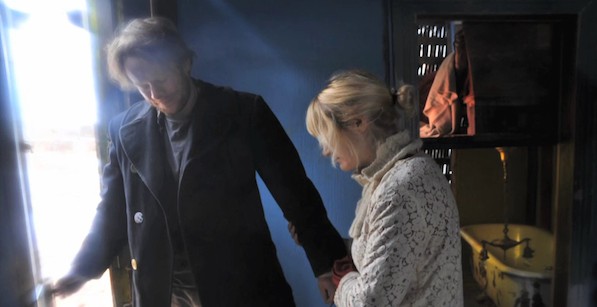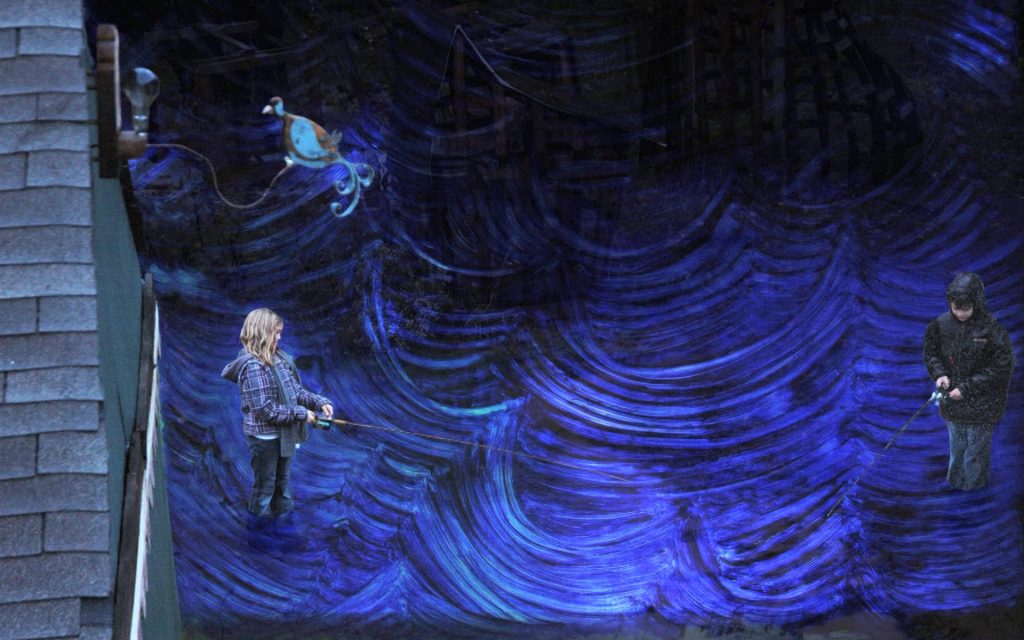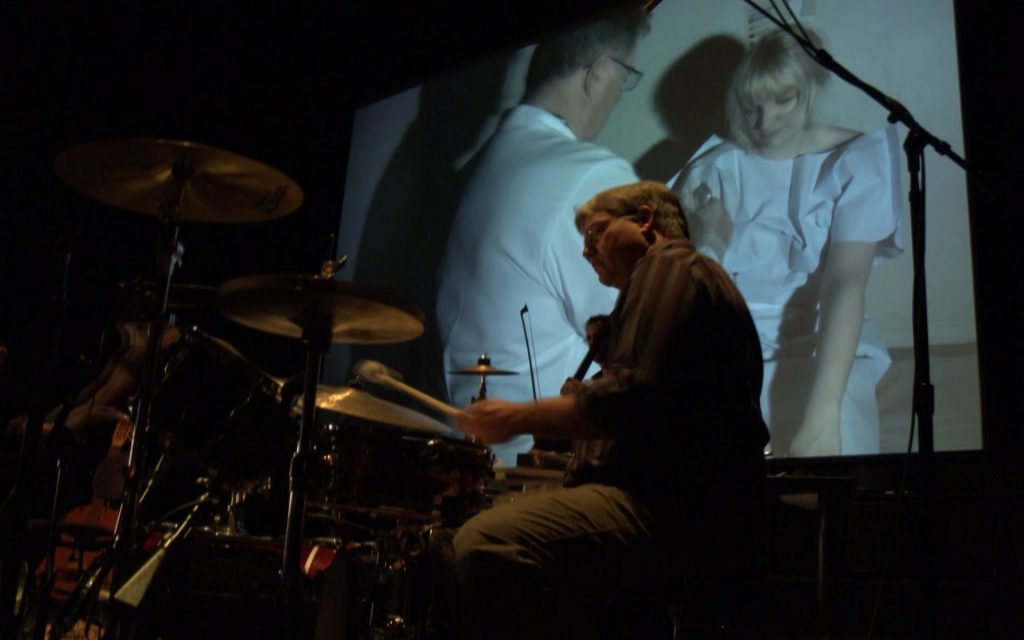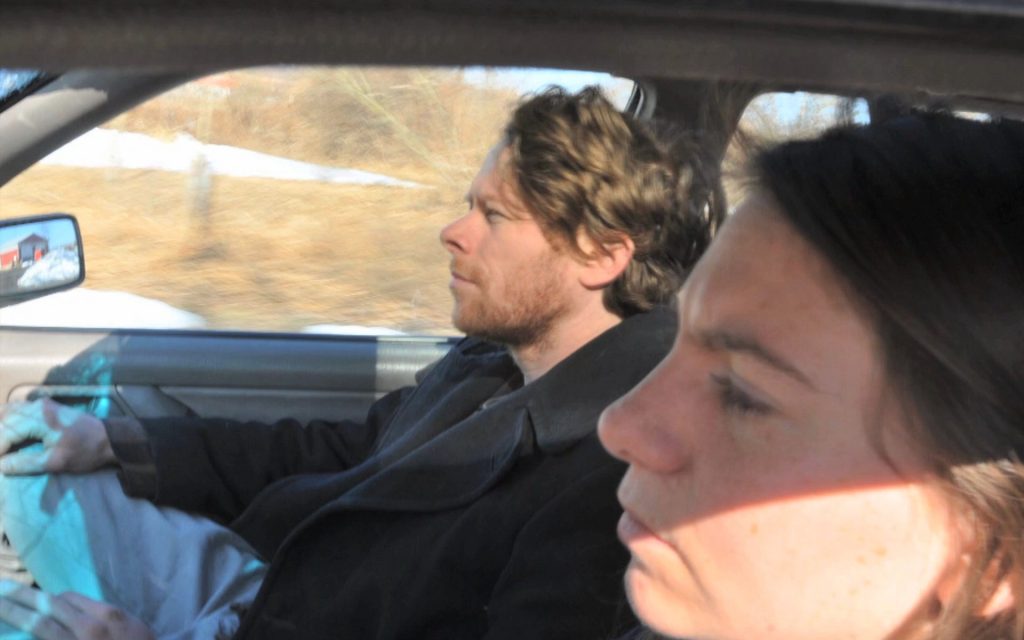Back in the spring of 2010, Brent Green drove a big U-Haul truck from rural Pennsylvania to the UC Berkeley Art Museum and Pacific Film Archive, where I work. Green was on his way to install his exhibition Perpetual and Furious Refrain. Inside the truck were parts of a thirteen-voice sound harmonium based on Thomas Edison’s early wax cylinder recorders, a kinetic chorus of figurative sculptures and the sole final cut of his recent feature-length film, Gravity Was Everywhere Back Then. The Museum’s curator, Elizabeth Thomas, was naturally dubious about this method of transporting artwork. What if the truck broke down? What if pieces were broken in transport? What if the final cut of the film was lost? U-Hauls are not considered an industry standard mode of transportation in the museum world. Green’s industry standard, however, might simply be described as precarity itself.
Green creates fictions that refute the dominant fictions of our world—narratives fueled by a relentless desire for money, or for the authority that money brings; cannibalizing desires that consume us from the inside. The insistence of the film and art worlds on the need for “industry standards” has a practical side, certainly, but it’s also based on a self-perpetuating desire to maintain the fiction that things only obtain value through money. Green insists on a different imperative: construct your own story. Do it with whatever materials are available, fail over and over again—and don’t ever stop. The story of Gravity is rooted in the fantastic precarity of going for broke. It is the love story of a man, Leonard Wood, trying to save his wife, Mary, from cancer by transforming their house into a healing machine.
“I don’t understand how he thought a lot of this stuff was going to work,” Green says of Wood. “I do now, but when I was down there I couldn’t understand for the life of me what a twenty-three foot high tower for a laundry room could possibly do to save someone’s life, until you realize that he was building towards God. All of his stuff was in the house when we went down to film it; we found the blueprints for his house and they were on cardboard. We found all of his bank statements—he worked in a hardware store—and he was completely broke—he had about seventeen cents in the bank almost all of time. A friend who was down there filming with me looked at me and said, you know, Brent, no one is ever going to care how much money you had in the bank in 1987. And that was a mighty thing to hear someone say, because I was really broke at the time. I realized that you were never going to die from running out of money.”
After discovering Leonard Wood’s unusual house in Louisville, Kentucky, on the set of Burn to Shine, Green decided to undertake his first feature-length film. But instead of seeking out funding and production managers, he started stripping the planks off of his family’s own burned-out house, and began building full-scale replica of Wood’s house behind his barn, along with four other clapboard buildings. Green was building his own his own healing machine. Like Paulina in his Paulina Hollers (2007) or his aunt in Carlin (2008), Leonard Wood’s homespun, desperate inventiveness fueled Green’s own. His healing machine was ramshackle by any standard, but it worked. The lights glowed, the piano played music and his friends gathered beside him to exhume the story of Leonard and Mary.
Their story goes something like this: Leonard Wood was, as Green describes, an “Appalachian Thelonious Monk.” A compulsive tinkerer, he relentlessly banged away at both his piano and his house, often imperfectly. Leonard’s true calling was revealed after Mary’s terminal diagnosis, and he started tinkering with new determination. As long as he kept working, he was certain, his house would summon God to heal Mary, and so his incessant handiwork was an invocation to change their fate. In telling their story, Green blended in his own fictions, “because memories go however you want them to be,” relating how Leonard and Mary fell in love, which involved a car crash that catapulted Leonard into Mary’s car, as well as a flood that threatens the stability of the house and reveals the fragility of Leonard’s homemade miracle.
Of course, the beauty of this is that Green’s homemade movie is driven by the same insane urgency that propels Leonard Wood’s homemade miracle—so much so that it’s difficult to distinguish Wood’s confabulations from Green’s. Since the entire seventy-five-minute film was shot as life-size stop motion animation on a consumer-grade Nikon digital still camera (even the car crash scene of Leonard flying through two windshields), Green’s work was necessarily obsessive, meticulous and utterly far-fetched. As opposed to Leonard however, Green keeps something of a critical distance from his quixotic zeal, although a deeply empathetic one: “I feel the same way about God as I feel about miracles. I would call on them, I would call on them, I would call on them…If I believed in them. But if I believed in them I’d be over and over let down. Gravity was everywhere back then.” With that, Green acknowledges that he doesn’t share Leonard’s unwavering faith in a higher authority, or even Leonard’s incredibly bad luck, but only in his urgency to salvage reality. As Green observes in To Many Men Strange Fates Are Given: “All men are made in God’s image the same way a stick figure drawing is created in man’s image. The resemblance is there, but no sane person would mistake the two.”
Precarious, impossible, in a culture clogged with slick production values and heavy price tags, Brent Green’s tales are complicated acts of defiance. Embracing characters like Leonard Wood means disavowing “industry standards” for production, or any other stable fictions, in exchange for a zeroed out bank account and a self-made world.
Unless otherwise indicated, quotes are sourced from Brent Green, for live screening of Gravity Was Everywhere Back Then at EMPAC on July 25, 2012.







